After pondering on it for a while, you are ready to become a pet parent.
Now, all you have to do is make a decision on the specific type of cat to bring home with you.
Perhaps you came across a brindled cat somewhere and fell in love with the coat color.
We can’t blame you. A cat with such a coat is hands down one of the most beautiful creatures you ever laid your eyes on.
However, there’s more to the brindled cat than meets the eye.
Before you shell your cash for the cute kitty on the breeder’s website or adopt one from the shelter, you are better off arming yourself with all the information about caring for her.
Here, we have broken down everything about a brindle cat for you.
What Is A Brindle Cat?

The term “brindle’ is not thrown around in the cat world much. It is mostly used in the canine world.
So, what exactly does it mean when someone tells you that the kitty you are looking at is a brindle?
Well, in its simplest form, a brindle cat is one with distinctive stripes, swirling patterns, dots, or lines around his body.
Others refer to this distinct coat color as the ‘tiger coat’ because the stripes appear like those of a tiger except that brindle cats have various color presentations as opposed to only black and white for a tiger.
Most brindled cats are black or red-based but they can also come in gray depending on how much black or red pigment is created.
The brindling presents itself in many ways. No two cats with this pattern and coloring look alike.
Some have broad stripes while others have narrow ones. The former doesn’t look like brindles at all but they are.
Most cats with brindle patterns often combine two colors – black and ginger red. The black can also be diluted gray. Other common brindle colors include orange, gold, and cream.
There are also brindle cats with diluted coloring such as chocolates and browns with darker fur.
It’s all about the genetics at play.
What Causes Brindling?
The female X chromosome is solely responsible for making the coat of the cat appear brindle.
The Y chromosome, essentially, doesn’t carry any code for coat color.
In the kitten embryo, the X chromosomes express different alleles at random. The expressed allele has a lot of impact on the resulting coat color.
As the kitten grows, the skin cells undergo division over and over again.
The cells carrying the alleles spread across the cat’s skin and give it a unique pattern, or brindle as we know it.
This reminds me of a common question among kitty owners, especially when it comes to brindle coat patterns:
Are Brindle Cats Always Female? Can Brindled Cats Be Male?
Well, because the X chromosome is the main player in brindling, cats with this specific coat are female.
Only 1 out of 3000 brindled cats is male. The rest are females. It’s really all in the genes.
See, females bear two X chromosomes carrying both black and orange coat colors. Males, on the other hand, have only one.
So, the coloring can either be black or orange and not both.
If you do find a male brindle cat, he will have the XXY combination of chromosomes and will be sterile because of this.
Types of Brindle Cats
Brindled cats come in two different types – mosaic and chimera.
Mosaic is the common pattern and features a coat with the traditional coloring mixed at random. It is also spread all over the body.
A cat with the chimera, on the other hand, has one brindle color on one side of his body and another on the other side. It can occur in the face as well as other parts of the body.
A brindle cat can also have tabby markings on the body and be called a torbie.
Brindle Cat Vs A Tortie Vs Torbie
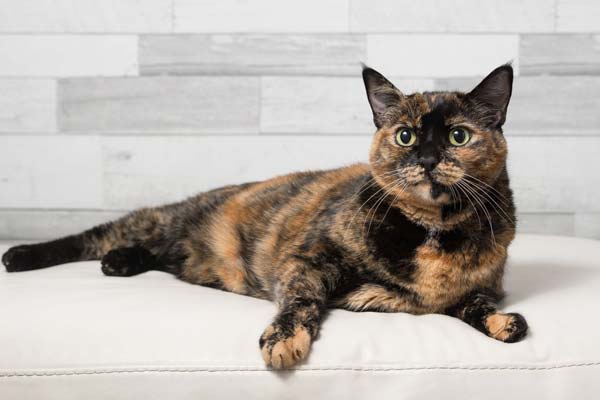
Brindle cats spark a lot of debates among curious feline lovers.
Some people say that a brindle cat is simply a cat with a tortoiseshell coat or a tortie.
Others also believe that the terms brindle and tortie mean the same thing.
And in some feline circles, a torbie can also pass as a brindle.
So, which is which? Are brindle cats different from torties and torbies?
Well, here’s a quick overview of these interesting coat patterns and colors:
A. Brindle
A brindled colored cat comes with stripes, swirling patterns, freckles, and dots across the body in a consistent manner.
The base is mostly brown overlain with black to brown stripes, making the kitty appear much like a colored tiger.
In some cats, the color appears blotchy but it is mostly consistent throughout the body.
B. Tortie
The term ‘tortie’ is short for a tortoiseshell cat.
As the name suggests, these kitties have coats that appear as the shell of a tortoise. They are bi-colored with cute marbled patterns.
Often, torties come in ginger red, and black but they can also have gold, orange, and cream colorings.
Torties mix two colors besides white in large or closely blended patches.
Brindle cats often pass as tortoiseshell cats or tabbies in some instances. So, it’s safe to say that a brindle kitty is a tortie.
Like brindle cats, torties are mostly female as the chromosomes that determine gender also affect their sex.
Females have two X chromosomes which both carry the code for black and orange colors.
The Y chromosome has no information on coat color. Male torties are rare and the few available ones are sterile.
C. Torbie
Torbies are special kinds of torties with tabby-like physical features. These striking felines look like tabbies with cream or red patches on their bodies.
Torbies are also called striped torties, patched tabbies, or reverse torties.
Like other tabbies, they have the “M” shaped mark on their foreheads. Their eyes, cheeks, tail, and legs also feature stripes.
A tortie is easily distinguished from a torbie as the latter has a tabby pattern which tortoiseshell cats shouldn’t have.
A torbie typically has red/orange speckles and black hair on its body.
Most torbies are female because of the reasons stated before.
Learn more here: What Exactly Is a Torbie Cat?
Are Brindle Cats Rare?
Brindle cats are not rare. If you are looking for one, you will likely find him in your local shelter, breeder, or rescue group.
The coat color is available in many common breeds including the Maine Coon and the Persian cat.
It may not be as common as the tabby color but it sure isn’t rare either.
With that said, male brindles don’t come easy (we’ve explained why in the previous sections).
1 in about 3000 cats with this coloring is male. The chance of coming across one is next to impossible.
Are There Brindle Cat Breeds?
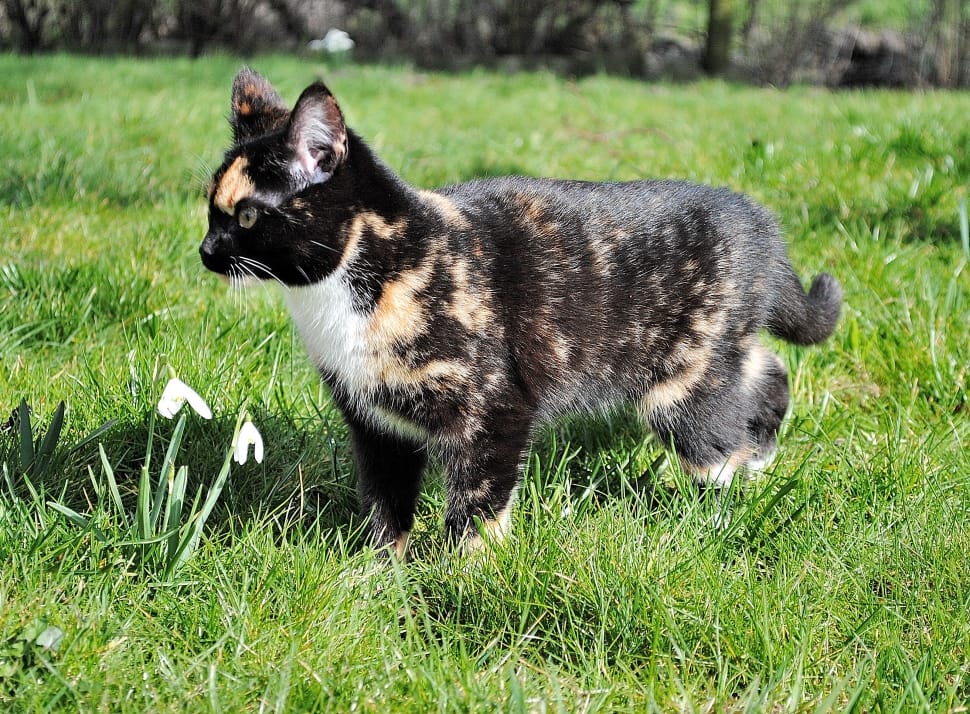
Brindle coat color is not specifically breed-specific. Any cat can spot the coat regardless of the breed.
Still, certain breeds are more likely to have brindled coat patterns. These include the following:
1. Bengal
With a strong, spotted, and muscular body, the Bengal cat looks like a jungle feline. However, he is quite affectionate and sweet as a pet.
Bengals come in many coat colors including brown tabby, silver tabby, black tabby, seal silver sepia tabby, and marbled/spotted patterns.
The breed is also available in the brindled cat color.
2. Persian
Secondly, the charming and hairy Persian also boasts a brindled pattern. The long-haired beauty also comes in other colors such as solid white, black, chocolate, red, and blue.
3. American Bobtail
The American bobtail is predominantly famous for its bobbed tail.
He’s also one of the most affectionate and active cat breeds out there.
Plus, he loves playing with kids of all ages as long as they don’t hurt him.
The color of the kitty varies and occasionally you will find a brindle cat color.
4. Abyssinian
The coloring of the Abyssinian cat breed sets it apart from all others.
Most of the fur on his body features a distinct brindle pattern with the color being darker along the kitty’s spine and softer under the neck and on the insides of the legs.
Brindle Abyssinians aren’t that common but they are available nonetheless.
5. Maine Coon
One of the most popular cats the world over, the Maine Coon is an amazing cat to own.
He is loyal, independent yet affectionate, and cautious without being mean.
His gentle disposition especially makes him great around children, dogs, and other cats.
Maine Coons come in almost every color and pattern—one of which is brindle.
Related Post: Abyssinian Maine Coon Mix: Is This the Right Kitty for You?
6. Egyptian Maui
The Egyptian Maui mainly comes in silver, smoke, or bronze spotted patterns. This is the official look of a show cat.
However, the breeds can also be found in solid black, blue smoke, blue spotted, and brindled.
These patterns may not be allowed in the ring but if you don’t care much about showing your pet, they are the best colors to choose.
Ideally, the coat coloring can occur in mixed and purebred as well as short-haired or long-haired felines.
Brindle Cat Personality
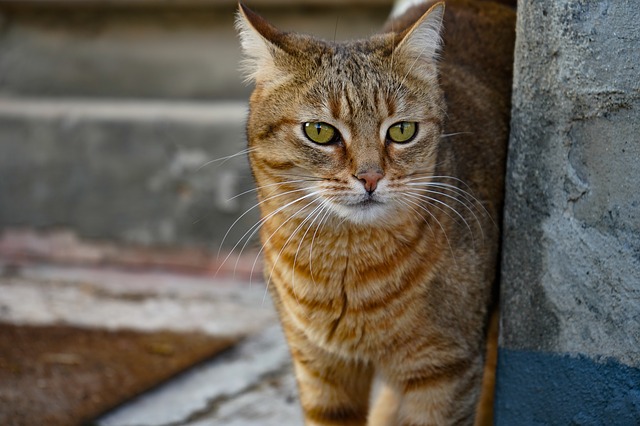
While brindle is not a breed-specific phenomenon, it has an effect on the personality of the kitty.
Cats with this distinct color have been known to have a sassy temperament.
This is loosely referred to as ‘tortitude’ out there, which is a combination of two words: ‘tortie’ and ‘attitude’.
Apparently, these little balls of fur can be quite feisty. They have actually earned the name of ‘divas of the cat world’ because they take will and independence to another level.
Many pet parents with brindle cats agree that their fur babies are divas for sure. They ooze confidence, wit, and aggression.
If you have another cat at home, the brindled one is less likely to warm up to her easily.
She can be standoffish and unaccepting of any attempt to make friends.
In case you have younger cats, the brindled one may give them a hard time.
Again, some of these things are based on the individual. Your story may go in the opposite direction.
Besides being sassy and confident, a brindle cat is a high-energy feline. This is not the kind to sit around the sofa all day.
If you have a yard, he will love to play out there. He will hunt rodents, dig holes for fun, climb up and down trees, and just enjoy his life.
Expect your brindle cat to also be talkative, happy, and always excited to hang with you.
If you have a number of people in your household, she will cultivate a different kind of relationship with every member.
It is said that this cat can even create a special greeting for each family member. She is free-spirited, fiery, headstrong, empathetic, and simply delightful to be around.
Brindle Cat Health
The pattern and color of a cat, fortunately, don’t influence the health of the cat.
It is not an issue that affects certain breeds only. Rather, it can happen to any and every breed.
As you shop around for a brindle cat, always pay extra attention to the breed to get her health information.
In general, felines are prone to ailments of the skin, kidneys, and mouth.
However, if you are ready to get your hands on a male brindle cat, keep in mind that he will have gene-related health problems, thanks to his complex genetic code.
Brindle Cat Lifespan
Like health, the brindle pattern has no direct correlation with the lifespan of the cat.
Again, the specific breed determines how long the feline lives.
A mortality and longevity study done in the UK consisting of 100,000 cats revealed that the average lifespan is 14 years.
PetMD puts the general lifespan at 10-15years.
Your kitty can surpass this target or live under it depending on the breed and care among other factors.
To have a rough idea of how long you will have your kitty, find out the lifespan of the specific breed of cat (with brindle coat pattern) you plan to welcome into your home.
In addition, consider:
- Neutering or spaying the cat to limit reproductive diseases
- Staying up-to-date with the cat’s vaccinations and vet check-ups
- Offering balanced meals and utmost care to your kitty
Speaking of care, we have have a few tips that may come in handy…
Brindle Cat Care
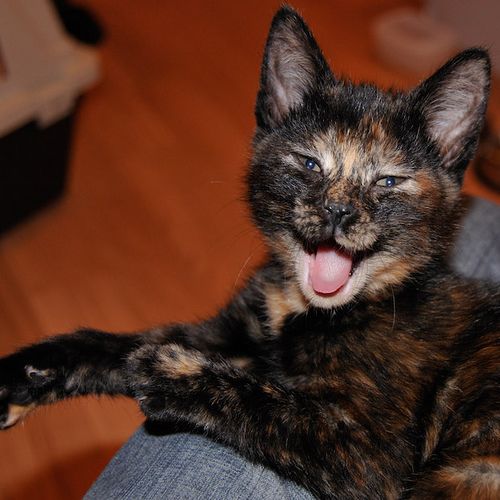
A brindled colored cat can only live a happy, healthy, and long life if you give him the care he deserves. That’s right—the amount of care that you give to your kitty can lengthen or shorten his lifespan.
If you own an outdoor cat, for instance, he may not live to see his 10th birthday if he is exposed to dangers of all kinds out there.
Indoor cats, on the other hand, can go for over 15 years if well cared for.
Here are some tips you can leverage when it comes to caring for a brindle cat:
- Learn the Breed: As mentioned before, the brindle coat pattern is not breed-specific. To know what your kitty is susceptible to, start by pinpointing the breed. This way, you can monitor any health conditions the breed is prone to and talk it over with the vet.
- Offer a carnivore-based diet with the right balance of minerals and vitamins. Depending on the breed and health of the kitty, give quality food that caters to his needs.
- Keep a Clean And Large Enough Litter Box: Dirty litter boxes can cause a host of health conditions including kidney infections, urinary tract infections, bladder infections, and bladder stones. Be sure to change your kitty’s litter box every day to keep these conditions at bay.
Read: Litter Box with Carbon Filter—An Ingenious Way To Maximize Odor Control
- Groom the Cat Frequently: Brindle cats come in both long-haired and short-haired types. The former requires more in the way of grooming than the latter. Either way, if you want your cat to have soft, healthy, and silky hair, you have no option but to groom him.
- Spay Or Neuter Them: Fixing the kitty limits the risk of contracting health conditions of the reproductive system.
- Offer the cat all the essentials he needs: These include a comfortable bed to lie on, a collar with an ID tag, scratching posts, a variety of interactive toys, and other things that makes him happy and healthy.
How Much Is A Brindle Cat?
It is difficult to put a figure on the price of a brindled cat kitten. The reason is that this is mostly a factor of the breed, not the color of the coat. And some breeds just cost more than others.
Generally, tortoiseshell cats cost anywhere from $1k-$2k depending on the coat color combination. The more striking the kitty is, the higher the price.
As torties, brindle cats fall within this range as well.
The cost depends on the breed as earlier said, geographical location of purchase, age, and breeding practices used.
Because of their rarity, male brindles may cost upwards of $2000.
If you are pressed for money, walk into your local shelter. If you are lucky to find one, you are looking at spending as little as $100-$150 for a brindle furball.
Other Important Facts about Brindle Cats
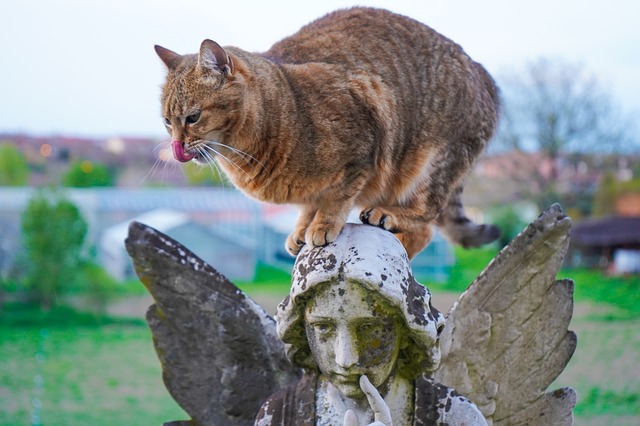
- Brindled cats are thought to bring good luck around the world. The Tortie is literally called “the money cat” in the United States. People believe that the breed brings good fortune. In the United Kingdom, it is claimed that the cat’s skin can heal warts.
- Besides being lucky, some people also believe a brindle cat is mystical and has superpowers. The Japanese believe that the Tortoiseshell cat offers protection from ghosts. Other countries including Scotland and Ireland also have such mystical beliefs.
- The brindle cat is Maryland’s official cat. The cat, a Maine Coon with tortoiseshell markings and white patches, became a symbol of the state in October 2001.
- A brindled cat can have a woven-like appearance or have huge sections over the body. You have to be careful to know the difference. No matter the type of brindling, this feline is a true beauty.
Final Thoughts
There it is – everything you need to know about a brindled cat.
Clearly, this is a strong-willed, energetic, and beautiful feline baby.
If you are blown away by the cute coat, we don’t see why you shouldn’t own one.
As long as you select the right kitten from the right breeder, you should be good to go.
Related Posts:
Pros and Cons of Owning a Ginger Tabby Cat
8 Grey Cat Breeds with Yellow Eyes

Hi! I am Eleanor Price. I started this website after my cat, Louie, almost died from a case of botulism (a type of food poisoning often caused by bacteria that grow on food items). Turned out that my cat’s diet was the problem. I have made it my duty to provide the best information and recommendations about everything cat lovers need to know about their felines’ health and wellbeing. My goal is to find the most informative content on anything feline-related and share it with fellow hardworking kitty lovers.

